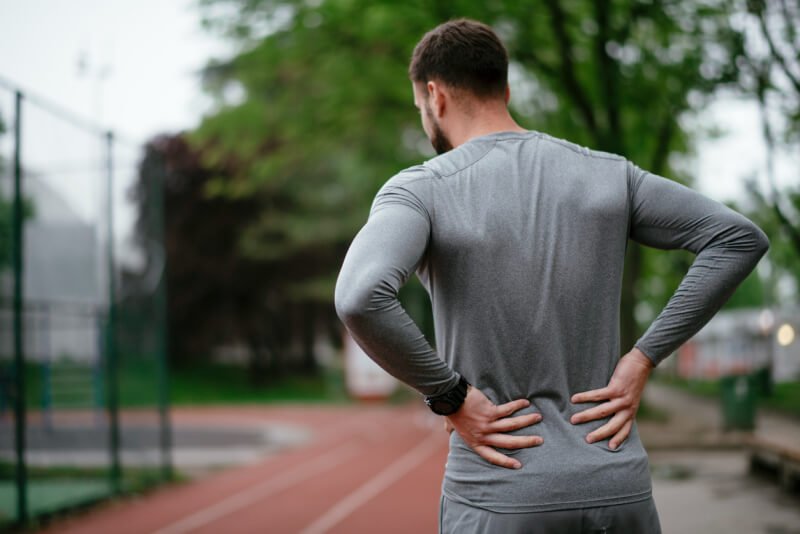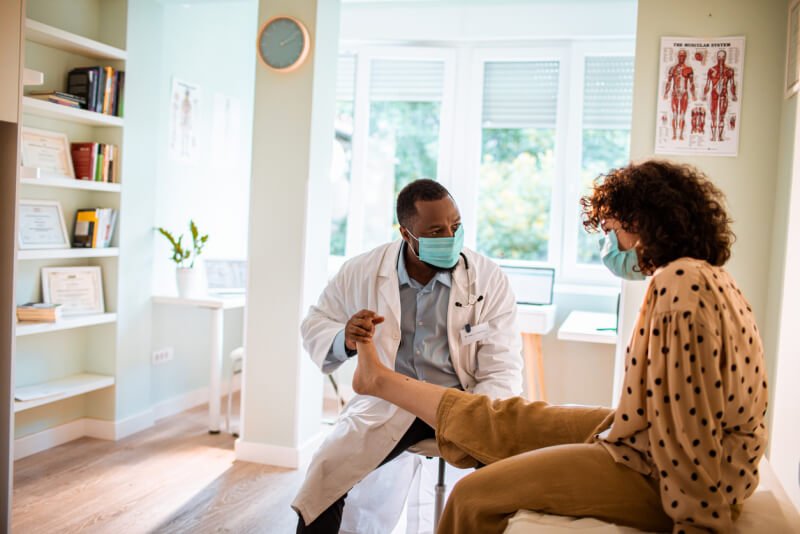 OUR LOCATIONSCall to book (212) 604-1300
OUR LOCATIONSCall to book (212) 604-1300
 OUR LOCATIONSCall to book (212) 604-1300
OUR LOCATIONSCall to book (212) 604-1300

Back problems are one of the most frequent complaints to doctors. It’s a common condition that’s usually treated with conservative treatment methods. However, if the lower back pain radiates to other parts of the body like the legs, it might be time to visit a spine specialist to determine its possible cause.
So what’s the possible reason for back pain to travel down to both legs? The leg pain you’re feeling on both sides might be a symptom of a spine condition that affects the lower back like sciatica, piriformis syndrome, herniated disk, osteoarthritis, degenerative spondylolisthesis, sacroiliac joint dysfunction, cauda equina syndrome, and degenerative disc disease.
According to a study by Georgetown University, around 8% of all American adults experience persistent back pain that affects their quality of life. Most of them have limited movements to avoid aggravating the back in the lower back. In some cases, the intense lower back pain travels down to the buttocks, thighs, and legs.
Since back pain is also one of the main reasons why American workers miss work days, it’s important to get the right treatment as soon as possible. Finding out the right treatment starts with determining the root cause of the lower back pain that radiates down to the legs. Here are some of the most common reasons for pain in the lumbar spine:
Sciatica is a type of radiculopathy caused by the sciatic nerve compression. The sciatic nerve is a thick motor and sensory nerve found in the lumbar spine and connected to the buttocks and both legs. The pain starts in the lower back that radiates down to the buttocks, thighs, legs, and feet. It only usually affects one part of the body, but some patients might also experience pain, numbness, tingling, or burning sensation in both legs.
Sciatic nerve pain might also be classified as either acute or chronic:
The piriformis muscle is found deep in the buttocks and behind the gluteus maximus. It starts at the lumbar spine and runs diagonally down to the upper surface of the femur. This muscle allows the hips to rotate and the legs and feet to turn.
Piriformis syndrome occurs when this muscle swells, tightens, or bleeds. This irritates the sciatic nerve that runs vertically behind the piriformis muscle. This condition causes patients to feel sciatica symptoms like a dull ache in their buttocks. The pain is also aggravated as the patient walks up the stairs or stays seated for too long.
The spine is made up of alternating vertebra and spinal discs. These discs are important in absorbing shock and cushioning each vertebra. Each disc is made up of a tough outer layer called annulus fibrosus and a soft gel-like core called nucleus pulposus. However, there are cases when tears develop in the outer layer of the disc, causing the inner core to spill out and press against the nearby spinal nerve.
Disc herniation that occurs in the lumbar spine is referred to as a lumbar herniated disc. It causes pain in the lower back region, which might extend down to the buttocks, thighs, legs, and feet if the sciatic nerve is affected.
Lumbar spinal stenosis is the narrowing of the spinal canal, which causes excess strain on the nerves and spinal cord in the affected area. It occurs because of the narrowing of lumbar or cervical spine and nerve canals, enlargement of facet joints, stiffening ligaments, and overgrowth of bone spur.
This condition typically develops in the lower spine (also called “lumbar stenosis”), causing pain, muscle weakness, cramping, and numbness in the lower back and legs. The symptoms might slowly develop over time, but some patients also reported feeling the sudden onset of pain. The symptoms might also come and go, but normal activities like walking or sitting may aggravate the pain and discomfort.
Osteoarthritis is a common type of arthritis that affects the spine. This condition is described as the inflammation of the facet joints and sacroiliac joints located in between the pelvis and the spine. Osteoarthritis of the spine occurs in the lower back as the cartilage between the joints slowly breaks down, causing pain and inflammation. But aside from natural degeneration, back injuries might also affect a person’s risk of developing spinal arthritis.
Patients with spinal arthritis often feel intense pain whenever they bend or twist their back. They might also feel stiff because of this. There might also be tenderness or swelling of the muscles over the affected vertebrae, as well as numbness in the legs in cases of spinal osteoarthritis in the lumbar area.
This condition occurs when one of the vertebras along the lumbar part of the spine slips forward over the vertebra below it. It might be a congenital condition, but children and adults may also develop spondylolisthesis later on. One of the common causes of spondylolisthesis is the physical stress of the spine as a result of trauma or injury, repetitive motion, incorrect way of lifting heavy things, and general wear and tear.
Aside from back pain in the lumbar spine, patients might also experience pain, tightness, or weakness that travels to one or both legs. The pain is usually aggravated with sudden twisting and movement.
The sacroiliac joint connects the hip bones to the lumbar spine. It’s responsible for absorbing shock between the pelvis and the upper part of the body, which is why it only has little motion. Sacroiliac (SI) joint dysfunction refers to the inflammation of this joint, causing pelvic pain and stiffness that radiates down to the legs.
SI joint dysfunction is usually aggravated when the patient moves too much or too little. Hypermobility causes instability in the pelvis, which leads to pain in the hip, lower back, and groin area. On the other hand, hypomobility causes pain and tension that further inhibits mobility and flexibility. Patients with SI joint dysfunction feel radiating pain from the lower back to the back of the legs because of hypomobility, which is why it’s often mistaken as sciatica.
This rare spine condition produces sciatica-like pain that starts from the lower back and travels down to the legs. It’s a medical condition that requires immediate surgical procedures because it might lead to serious complications like impaired bowel and bladder control, paralysis, and other neurological disorders.
The cauda equina is a bundle of nerves that extends from the spinal cord down to the lumbar spine and the back of each leg. It’s responsible for relaying motor and sensory information to the pelvis and lower limbs. Patients often experience sudden and severe pain or other symptoms as a result of the inflammation of the cauda equina.
The vertebral discs along the spine usually wear down as people age, but they may also be a result of repetitive movements or trauma from an accident. The spinal discs might become too thin or dehydrate, creating a narrower intervertebral disc space. This puts pressure on the sciatic nerve root, causing lower back and leg numbness or pain.
Degenerative disc disease is often confused with herniated discs because of their similarities when it comes to symptoms. However, the spinal disc of a patient with degenerative disc disease is much more dehydrated than that of a patient with a herniated disc. On the other hand, discs herniate because of a wrong movement that’s not necessarily gradual wear and tear.

Back pain that radiates down to both legs is a sign of a serious medical condition that requires immediate attention. After finding out the main cause of the back, leg, or hip pain, patients might be prescribed one or a combination of the following treatments:
It’s normal for patients to attempt pain relief at home first before consulting a medical professional. Some of them are effective in relieving back and leg pain, such as applying ice or hot packs and stretching.
Ice packs are useful for reducing pain and swelling in the affected area. Remember to apply the ice pack for at least 20 minutes a day. Switch to using a heating pad after a few days of using the ice pack. Patients may switch between cold and hot packs until they feel a lot more comfortable.
There are also gentle stretches that patients can perform at home to help alleviate back pain and strengthen muscles. Just make sure to learn the stretches from a trained physical therapist first to avoid discomfort and worse complications.
Learn more: 9 Simple Stretches for Lower Back Pain Relief
Some over-the-counter medications are also useful in minimizing swelling and inflammation. NSAIDs are the most effective ones, but those who prefer taking aspirin should limit their intake because it causes bleeding and ulcers for some people.
If the pain is too severe, doctors may also provide a prescription for stronger medications like cyclobenzaprine to reduce pain and discomfort caused by muscle spasm. Other pain relief prescription medications are anti-seizure medication, opioids, and antidepressants.
Learn more: The Strongest Painkillers for Back Pain
Physical therapy involves finding the right exercise movements that decrease the frequency and intensity of sciatica by relieving the excess pressure on the pinched nerve. Most physical therapy sessions involve stretching exercises, but doctors might also recommend other methods like heat therapy and electrical stimulation.
Spinal injections utilize corticosteroid injections that are directly delivered into the facet joints or affected nerve roots to reduce pain and swelling. Patients who opt for spinal injections usually feel pain relief for about three months.
Alternative therapies like acupuncture and chiropractic care are also widely used as a treatment for different kinds of pain. Acupuncture involves poking the pressure points with thin needles to relieve tension while chiropractic medicine manually realigns the spine to alleviate pressure. Both treatments are generally safe as long as they’re performed by a certified acupuncturist or chiropractor.
A surgical procedure isn’t always required for most cases of lower back pain unless the patient has been diagnosed with cauda equina syndrome. Surgery is only recommended for patients who still don’t experience pain relief after trying out different treatments. It’s better to consult a spine specialist first to find out if a surgical procedure is the right treatment method for your condition.
Learn more: A Guide to Lower Back Pain Relief
Here at our top-rated NYC sports injury clinic, we want our patients to experience pain relief using the best non-surgical methods. We work with the country’s top spine specialists to provide a holistic approach to each patient’s treatment plans. Our highly trained staff always prioritizes patient comfort and safety, so feel free to ask them anything you need to know about our services.
Start your journey to a pain-free life today by calling (646) 762-9336 and booking a consultation with one of our experts today. Read more about us and our effective back and spine treatments on our website.






